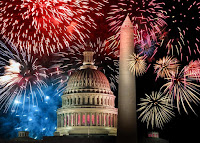Chinese Fireworks Light Up US Skies on July 4th

The Chinese technology will be on full display in the United States as America celebrates its Independence Day today. As the world's factory, China's fireworks industry provides 98 percent of America's overall needs, and 80 percent of the pyrotechnics needed for professional displays. Liu Donghui, the secretary-general of China-based International Fireworks Association, told the USA Today that Liuyang's factories alone produced $1 billion worth of fireworks last year, some $430 million of it to meet overseas orders.
Chinese fireworks business literally booms every 4th of July as millions of pounds of explosives soar as high as a thousand feet in America's skies, creating beautiful patterns of red, white, blue and other colors. The U.S. has celebrated its Independence Day with increasingly spectacular fireworks since the first celebration in 1776 when John Adams ordered that July 4 should be marked with “illuminations from one end of this continent to the other from this time forward forevermore.”
Fireworks originated in China some 2,000 years ago. China's Liu Yang region of Hunan Province continues to be the factory of the world for fireworks. It is important to remember the geographic origin of fireworks, because often critics of the fireworks industry say that fireworks are produced in China to take advantage of cheap labor. But the reality is that the fireworks industry developed in China long before the modern era of globalization and long before the disparity in east-west wage rates. The rapid industrialization of China during the last two decades has only strengthened its fireworks industry exports.
Pyro Spectaculars, one of the family-run firms that dominate U.S. fireworks, puts on the New York fireworks show, according to the Wall Street Journal. Its chief executive, James Souza, makes several scouting trips to Liu Yang, China, each year to meet with manufacturers about new shells, cardboard balls as wide as 12-inches in diameter, filled with gun powder and chemicals. The rest of the year he spends at a 160-acre World War II military munitions facility in the desert outside Rialto, Calif. There, at Pyro headquarters, he can freely test explosives.
While the basic chemistry of fireworks has not changed much since its early origins in China, there have been dramatic advances in how the pyrotechnic shows are created and managed for their spectacular visual and sound effects synchronized to music. The extravagant pyrotechnic shows have now become a beautiful blend of art and science.
New microchips embedded in shells now make it possible for fireworks to explode at a specific height. Last July 4, Grucci’s of New York wrote “U.S.A.” in the sky as singer Lee Greenwood’s “God Bless the U.S.A.” played, reports the Wall Street Journal. It’s tricky to get a shell to break precisely so that it looks like an M, not a W. Next year’s goal: high-definition bursts that explode at lower levels but look crisp on TV.
According to the Journal, fireworks companies began using computers in the late 1980s to remotely ignite fireworks with an electric match that makes contact with a gun powder fuse. The gun powder, called “black powder,” launches the shell skyward. When the fuse reaches the explosive matter inside the shell, the firework goes off and the stars explode in a fixed pattern and color. Popular “cakes,” the name for a cluster of fireworks linked with a single fuse that burst at various heights, are called “Apocalypse Now,” “One Bad Mother-in-Law,” and “Dante’s Inferno.”
In addition to hundreds of millions of dollars worth of Chinese fireworks, most of the US flags, estimated at $5 million dollars a year, on display on this 4th of July are imported from China as well.
So the Chinese fireworks and flag businesses celebrate 4th of July each year with the Americans by exporting what America needs to have fun on its Independence Day each year.
Fireworks and flags are among the myriad exports from industrialized China that make up about 25% of the Chinese economy, significantly higher than the exports accounting for 15% of India's GDP and only 10% of Pakistani GDP among the less globalized economies in South Asia.
Related Links:
Chinese PLA's Role in Industrialization
China's Checkbook Power



Comments